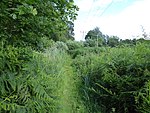Sutton Hoo Helmet (sculpture)

Sutton Hoo Helmet is a 2002 sculpture by the English artist Rick Kirby. A representation of the Anglo-Saxon helmet by the same name found in the Sutton Hoo ship-burial, it was commissioned by the National Trust to suspend outside an exhibition hall at the Sutton Hoo visitor centre. At the opening of the centre, the sculpture was unveiled by the Literature Nobel laureate Seamus Heaney on 13 March 2002. It remained in place, dominating the entrance of the exhibition hall, until 2019, when it was moved to the entrance to the Sutton Hoo site. The sculpture is 1.8 m (5.9 ft) high, 1.2 m (3.9 ft) wide, 1.6 m (5.2 ft) deep, and weighs 900 kg (2,000 lb). It is made of mild steel plates that are coloured red. Designed to have a "fierce presence", it is inspired by the fragmentary appearance of the reconstructed helmet rather than the glistening replica made by the Royal Armouries. Steel is Kirby's favoured medium, allowing the sense of scale and dramatic impact found in Sutton Hoo Helmet. The sculpture is illustrative of Kirby's largely figural body of work, and its mask-like quality has been repeated in subsequent pieces.
Excerpt from the Wikipedia article Sutton Hoo Helmet (sculpture) (License: CC BY-SA 3.0, Authors, Images).Sutton Hoo Helmet (sculpture)
B1083, East Suffolk
Geographical coordinates (GPS) Address Nearby Places Show on map
Geographical coordinates (GPS)
| Latitude | Longitude |
|---|---|
| N 52.0948 ° | E 1.3415 ° |
Address
B1083
IP12 3DH East Suffolk
England, United Kingdom
Open on Google Maps











